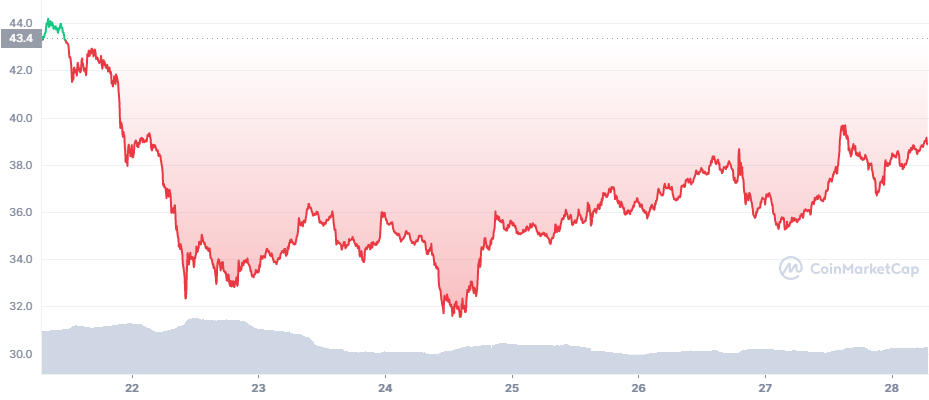Why FTX Token (FTT) Defies the Market

The cryptocurrency market stalled in its recovery, dragging down Bitcoin (BTC) just above $37,000 with an additional weakness for Ethereum (ETH).
Most altcoins also continued to slide, with the exception of the FTX Token (FTT), the native asset of the FTX Exchange.
FTT grew to $38.20, from a most recent low of around $32, up 2.5% in the past 24 hours. The token is still near a three-month low and is about 50% down from its all-time high. But the fast recovery on growing volumes shows derivative trading is here to stay, with the potential to accrue new positions after the latest series of liquidations.
FTT is viewed as one of the assets potentially continuing to benefit even during a bear market. If the FTX Exchange continues to attract users and turns into the biggest crypto market, the value of FTT may reflect the fund inflow.
At current prices, more extreme predictions see FTT follow the trajectory of Binance Coin (BNB), which easily achieved three-digit valuations. So far, FTT has failed to touch the $100 range, but the 2,400% yearly growth in FTX Exchange trading volumes may continue to boost the token in the coming months.
What is the FTX Token (FTT)
FTT is a multi-chain token represented on Ethereum, Binance Smart Chain, and Solana. FTT is the most active on Ethereum, with 24,254 addresses. The Solana bridge smart contract holds more than 12M tokens as Wrapped FTT to use on Solana DeFi, decentralized exchanges, and for other trading purposes.
The token wraps up three of the most active trading pairs on the FTT exchange. The token has a turnover of $251M in trades in 24 hours.
Exchange tokens usually offer advantages in paying lower fees for some trades. The FTT token takes up just a small portion of overall FTT trading, which has reached above $12B in 24 hours.
What Made the FTX Exchange Popular
The FTX Exchange started off as another small market operator to compete with exchanges well-established in cryptocurrency trading, including Kraken, Binance, OKExbi and others.
FTX started with organic growth but added aggressive marketing and fundraising in the past year. Combined with the bull market and interest in derivatives, FTX soon boosted its account number and trading volumes.
The decision to become a multi-chain exchange added to the usage of the platform. In previous years, rapid growth was viewed with skepticism as the effect of bots or faked accounts. But FTX has shown real growth in spot and futures markets.
The FTX Exchange saw some of the record liquidations in the middle of 2021, and broke its spot trading record last November, at $13.9B in 24 hours. Most of the volumes on FTX come from USDT pairings.
FTX also has a relatively small pairing with Bitcoin (BTC), becoming the third-largest spot market for trading the leading coin.
FTX Affects Altcoin Markets
Beyond BTC and Ethereum (ETH) derivatives, FTX has opened leveraged markets for altcoins. One of the risks for altcoins is a short squeeze, as a less liquid market may be easier to attack.
FTX funding anomalies may signal coin moves and potential rapid price swings for small-scale altcoins.
The exchange is a source of abnormal funding rate signals for multiple pairings. FTX carries 100 trading pairings in total, with derivative markets for multiple coins and tokens.
FTX Exchange has also become a source to glean the behavior of traders, as activity is now highly concentrated on this exchange and can reveal trends in trading decisions.
FTX Exchange encompasses the full extent of digital assets, including NFT collections. The exchange is also a fiat off-ramp between stablecoins and fiat, accepting multiple currencies through bank wire transfer.
FTX Exchange is owned by a company based in Gibraltar. Along with a list of banned territories due to terrorism financing laws, FTX Exchange is closed to US-based traders.
FTX Exchange Founder Gets the Spotlight
The conception of FTX as an exchange for active traders has paid off, by attracting the newest inflow of crypto trading enthusiasts. The success of FTX was one of the goals of the market’s founder, Sam Bankman-Fried.
SBF, as he is also known, took up crypto trading as a tool toward his goal of altruism and charity donations. He was recently featured in a Nas Academy video.
SFB is a long-term crypto enthusiast and has recently shown interest in Web 3 technologies. In a recent talk, he discusses the potential of blockchain startups to achieve Web 3 infrastructure with applications such as metaverse worlds and play-to-earn games.
The rapid rise of FTX shows cryptocurrency trading is evolving, with no one market guaranteed to draw in the most funds and leverage.

Uphold makes buying crypto with popular currencies like USD, EUR and GBP very simple with its convenient options to swap between crypto, fiat, equities, and precious metals.

With over 50 coins and an obsession with security, Kraken is one of the safest places to buy and trade crypto.

Kraken has a good reputation for security and protection of your funds and operates across the USA (except NY), Canada, the EU and Japan

Based in Charleston, South Carolina. Serves over 184 countries and has done over $4 billion in transactions. Offers convenient options to swap between crypto, fiat, equities, and precious metals.

A beginners guide to candlesticks, trend line, indicators and chart patterns

Crypto investment remains unpredictable and risky, but good practices can save you from many of the potential pitfalls.

IOTA is a feeless crypto using a DAG rather than a blockchain. It aims to be the currency of the Internet of things and a machine economy.

The first cryptocurrency. It has limitations for transactions but it is still the most popular being secure, trusted and independent from banks and governments.